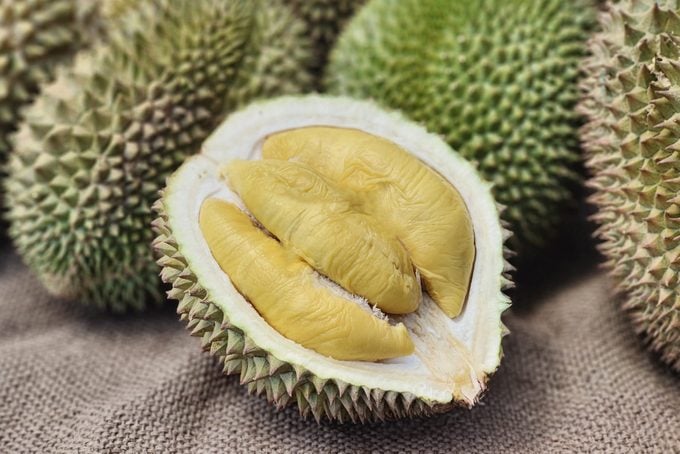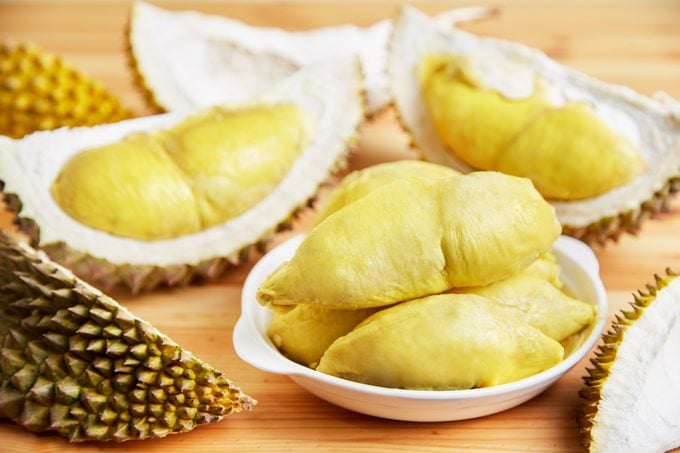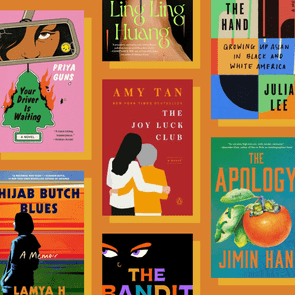This Is the World’s Stinkiest Fruit—and Why It Smells So Bad
Updated: Jul. 14, 2023

It may smell like sweaty socks, but it's also considered a delicacy
Nicknamed “the king of fruits,” durian is one of the most popular foods in Southeast Asia. Beloved by millions, it’s considered a delicacy. There’s only one catch: It’s also known as the stinkiest fruit in the world. The durian fruit smell has been compared to garbage, raw sewage and sweaty socks!
In fact, durian smells so pungent that it has famously been banned from public transit, airports and hotels in Thailand, Malaysia, Singapore, Hong Kong and other locales. Let’s just say, it’s definitely an etiquette mistake to open it in small, enclosed spaces.
Because of its stinky reputation, you won’t see it in glamorous Asian movies like Crazy Rich Asians. And unlike other treats, such as the ever-popular bubble tea, it hasn’t caught on in the U.S. for the same reason. Many fanatics of food facts are only familiar with durian because of its smelly quality, but it’s an incredibly popular snack in China and Southeast Asia.
So what exactly is durian, and what makes it smell so bad? And given its not-so-fragrant reputation, why do people love it so much?
What is durian?

Durian is a fruit that’s native to southern China and Southeast Asia. It’s large, with a spiky brown-green exterior you split open to eat the fruit. (The spines are so sharp that there have been a few recorded deaths by durian—imagine reading that in an obituary!) Inside is thick, pulpy, custardy fruit that grows around large seeds, similar to avocado pits. The flesh can range in color from red to golden yellow, but it’s generally a pale yellow.
And while durian is renowned for its bad smell, it’s also incredibly popular in Malaysia, Thailand, China and Indonesia, among other places. It’s even considered a delicacy, and priced accordingly—it’s not unusual to see durian that costs $20 to $30 a pound!
What does durian smell like?
Durian fruit smell is very distinctive but hard to describe. Once you smell it, you’ll recognize it anywhere—all the way down the street! I tried durian with a Malaysian friend, and it was definitely a unique experience.
To try to picture what durian smells like, imagine if fruit was stored in a teenage boy’s sweaty gym sock. The scent was thick and funky, like cutting onions, but mixed with that ripe-fruit smell you get from over-soft mangoes. It definitely has elements of garlic and rotten egg. It smelled like a girls’ seventh-grade gym class: a mix of BO and melon-scented body mist. Like fruit-funk. The sticky parts of the floor in an Asian market. A lit candle that is sandalwood and stress-sweat scented. Eau de toilette sprayed on bleu cheese. Vanilla pudding being cooked in a public bathroom. Are you getting a mental (nasal?) image yet?
My friend offered a different perspective: She never understood why people think durian smells so bad. It’s a specific smell, for sure, and certainly potent. But for her, it’s just the smell of fruit stalls in Malaysia.
Why does durian smell so bad?

What makes durian so stinky? A scientific study broke down durian’s pungent odor into 44 different scent-producing chemical compounds. One of the most interesting facts from the report is that it was the first time three of those compounds had ever been detected in a natural product. That’s why durian smells so unique—chemically, there’s nothing else quite like it!
But it isn’t any one compound that results in the infamous durian fruit smell, it’s the combination of them all. The researchers described each of the odor compounds they detected in durian; the list includes honey, roasted onion, sulfur, caramel, soup seasoning, rotten egg, rotten cabbage, skunk and fruit.
What does durian taste like?
Thankfully, durian tastes better than it smells! It has a complex flavor that’s not quite like any other fruit.
Personally, I think durian has a tropical taste, with the same kind of almost floral undertones you get in lychee. I found it fruity but with a distinct funk, like onion or brie cheese. It’s got a sweet vanilla cream taste, overlaid with a savory garlic flavor. My friend compares it to cream cheese, with a flavor that can waver between savory and sweet. The flesh is thick and custardy, in a pulpy kind of way.
Durian comes in a huge variety of flavors, depending on the strain and the growing conditions. Online, durian-tasting tour guides promise fruit that tastes like a caramel apple, a Snickers bar and more. Each individual fruit is described as having different undertones of chocolate, coffee and custard. Some durian can be more sweet, more sour or more savory than others. The flavor of durian even changes within the fruit itself: the pulp on the outside tastes different from the pulp closest to the seeds!
How is durian eaten?
To eat durian, you tear off the spiky exterior and slurp the fruit off the seeds. But be warned: Durian fruit smell can linger indoors. To air out the odor, treat it like you would get rid of a fish smell from your kitchen. In Malaysia, it’s common to see locals spreading newspaper across their front stoop to eat their fresh durian outside.
Durian is a popular flavor in snacks, cakes, candies and more. It’s also used in some savory meals—perhaps most memorably in Pizza Hut’s durian pizza, a limited-edition offering in Shanghai. Although I can’t vouch for its flavor, I can say that the pizza was popular enough that it was sold out when we tried to order it.
Can you get durian in the U.S.?
Durian is not one of the foods that are illegal in the U.S., so yes, you can buy it! Don’t let the smell put you off: Durian is worth trying, even if only to be adventurous.
It’s not likely to be at your corner store, but you can find fresh and frozen durian at many Asian grocers. Costco also sells a large pack of frozen durian pulp. However, the durian you buy in the U.S. won’t be the same as you would get fresh in Southeast Asia. Even if you buy a whole durian rather than frozen pulp, it will still have been frozen during transit.
More notably, most durian that is sent to overseas markets is bred specifically for exporting. For the U.S. market, that commonly means durian that has a less pungent “durian fruit smell” and a more uniform taste.
If you want to try durian, the best way to start is with some durian ice cream, which shouldn’t have a strong smell. It’s an interesting sweet treat, and you’ll get to see why so many people love the fruit—odor and all.
Source:
Journal of Agricultural and Food Chemistry: “Characterization of the Major Odor-Active Compounds in Thai Durian“




















